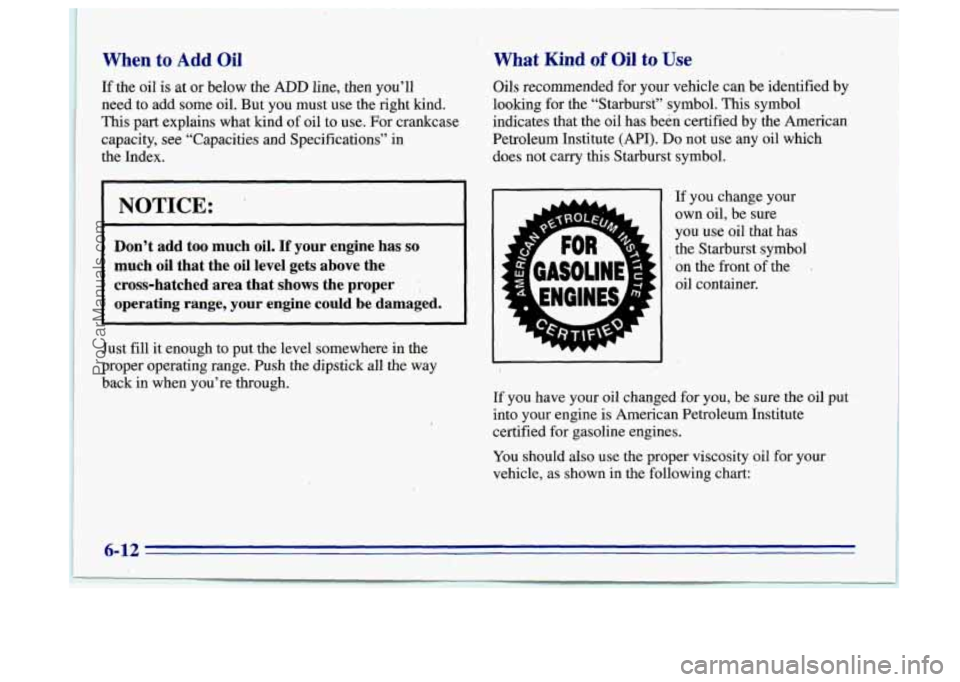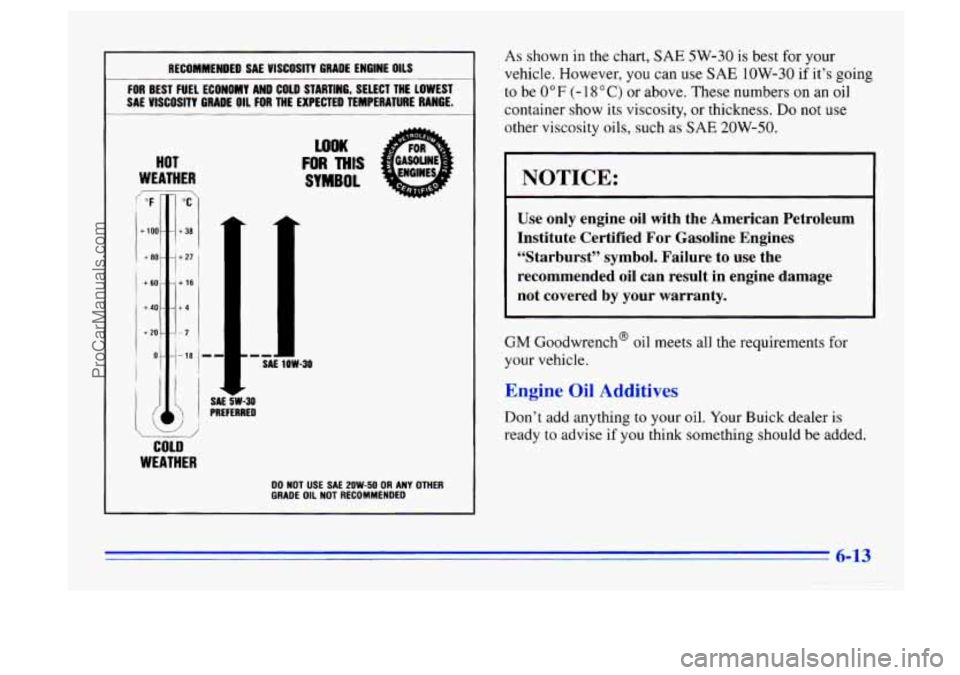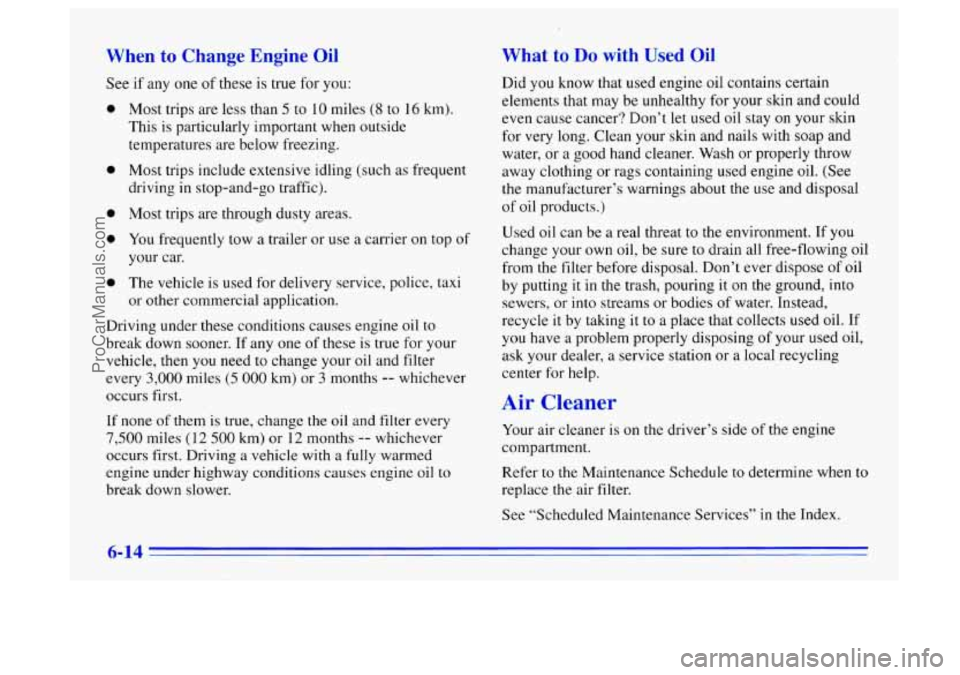Page 214 of 340
When you open the hood of your 2.2L engine you’ll see:
D. Engine Oil Cap and Dipstick G. Engine Fan
E. Automatic Transaxle Dipstick H. Air Cleaner
F. Brake Fluid Reservoir 1. Battery
A. Windshield Washer Reservoir
B. Engine Coolant Reservoir
C. Power Steering Reservoir
6-8
ProCarManuals.com
Page 215 of 340
When you open the hood of your 3.1 L engine you’ll see:
A
A. Windshield Washer Reservoir
B. Engine Coolant Reservoir
C. Power Steering Reservoir
D. Automatic Transaxle Dipstick
E. Oil Fill Cap
E Engine Oil Dipstick
G. Brake Fluid Reservoir
H. Engine Fan
I. Air Cleaner
J. Battery
6-9
ProCarManuals.com
Page 216 of 340

Things that burn can get on hot engine parts and
start a fire. These include liquids like gasoline,
oil, coolant, brake fluid, windshield washer and
other fluids, and plastic or rubber. You or others
could be burned. Be careful not
to drop or spill
Underhood Lamp
Your underhood lamp is designed to come on whenever
you raise the hood.
Engine Oil
It's a good idea to check your engine oil every time you
get fuel. In order
to get an accurate reading, the oil must
be warm and the vehicle must be on level ground.
things that will burn onto a hot engine. Turn off the engine and give the oil a few minutes to
drain back into the oil pan. If you don't, the oil dipstick
Before closing the hood, be sure all the filler caps
are on properly.
Then lift the hood
to relieve pressure on the hood prop.
Remove the hood prop from the slot in the hood and
return the prop
to its retainer. Then just let the hood
down and close
it firmly. might
not show the actual level.
Checking Engine Oil
Pull out the dipstick and clean it with a paper towel or
cloth, then push it back in all the way. Remove it again,
keeping the tip down, and check the level.
6-10
ProCarManuals.com
Page 217 of 340
I
3.1L V6 Engine
The 3.1L V6 engine oil dipstick is yellow and is located
near the front and center
of the engine compartment.
2.2L L4 Engine
The 2.2L L4 engine oil dipstick is located in the fill cap
near the front and center of the engine compartment.
ProCarManuals.com
Page 218 of 340

I
When to Add Oil What Kind of Oil to ‘Use
1
If the oil is at or below the ADD line, then you’ll
need to add some oil. But you must use the right kind.
This
part explains what kind of oil to use. For crankcase
I capacity, see “Capacities and Specifications” in
+he Index. Oils recommended
for your vehicle can be identified by
looking for the “Starburst” symbol.
This symbol
indicates that the oil has been certified by the American
Petroleum Institute (API).
Do not use any oil which
does not carry this Starburst symbol.
NOTICE:
Don’t add too much oil. If your engine has so
much oil that the oil level gets above the
cross-hatched.area that shows the proper
’,
operating range, your engine could be damaged.
Just fill it enough to put the level somewhere in the
proper operating range. Push the dipstick all the way
back in when you’re through.
If you change your
own
oil, be sure
you use oil that has
the Starburst symbol
on the front
of the
oil container.
If you have your oil changed for you, be
sure the oil put
into your engine is American Petroleum Institute
certified for gasoline engines.
You should also use the proper viscosity oil for your
vehicle, as shown in the following chart:
6- 12
ProCarManuals.com
Page 219 of 340

RECOMMENDED SAE VISCOSITY GRADE ENGINE OILS
FOR BEST FUEL ECONOMY AND COLD STARTING, THE LOWEST
SAL VISCOSITY GRADE OIL
FOR THE EXPECTED ILL -AlURE RANGE.
HOT
WEATHER
WOK
FOR THIS
SYMBOL
17
+ 100-
+EO-
1
I
t 60“
t 40.
+ 20 ’
O! I
+ 16
c4
COLD
WEATHER
DO NOT USE SAE 2OW-50 OR ANY OTHER GRADE OIL NOT RECOMMENDED
As shown in the chart, SAE 5W-30 is best for your
vehicle. However,
you can use SAE low-30 if it’s going
to be 0°F (- 18°C) or above. These numbers on an oil
container show its viscosity, or thickness.
Do not use
other viscosity oils, such as SAE 20W-50.
NOTICE:
Use only engine oil with the American Petroleum
Institute Certified For Gasoline Engines
“Starburst” symbol. Failure
to use the
recommended oil can result in engine damage not covered by your warranty.
GM Goodwrench@ oil meets all the requirements for
your vehicle.
Engine Oil Additives
Don’t add anything to your oil. Your Buick dealer is
ready to advise if you think something should be added.
ProCarManuals.com
Page 220 of 340

When to Change Engine Oil
See if any one of these is true for you:
e
e
e
e
a
Most trips are less than 5 to 10 miles (8 to 16 km).
This is particularly important when outside
temperatures are below freezing.
Most trips include extensive idling (such as frequent
driving
in stop-and-go traffic).
Most trips are through dusty areas.
You frequently tow
a trailer or use a carrier on top of
your car.
The vehicle is used for delivery service, police, taxi
or other commercial application.
Driving under these conditions causes engine oil to
break down sooner. If any one of these is true for your
vehicle, then
you need to change your oil and filter
every
3,000 miles (5 000 km) or 3 months -- whichever
occurs first.
If none of them
is true, change the oil and filter every
7,500 miles (12 500 km) or 12 months -- whichever
occurs first. Driving a vehicle with
a fully warmed
engine under highway conditions causes engine oil to
break down slower.
What to Do with Used Oil
Did you know that used engine oil contains certain
elements that may be unhealthy for your skin and could
even cause cancer? Don’t let used oil stay
on your skin
for very long. Clean your skin and nails with soap and
water, or
a good hand cleaner. Wash or properly throw
away clothing or rags containing used engine
oil. (See
the manufacturer’s warnings about the use and disposal
of oil products.)
Used oil can be a real threat to the environment. If you
change your own oil, be sure to drain all free-flowing oil
from the filter before disposal. Don’t ever dispose of oil
by putting it
in the trash, pouring it on the ground, into
sewers, or into streams or bodies
of water. Instead,
recycle it by taking
it to a place that collects used oil. If
you have a problem properly disposing
of your used oil,
ask your dealer, a service station or a local recycling
center for help.
Air Cleaner
Your air cleaner is on the driver’s side of the engine
compartment.
Refer to the Maintenance Schedule to determine when
to
replace the air filter.
See “Scheduled Maintenance Services” in the Index.
6-14
ProCarManuals.com
Page 223 of 340

Automatic Transaxle Fluid
A good time to check your automatic transaxle fluid
level
is when the engine oil is changed.
Change both the fluid and filter every
50,000 miles
(83 000 km) if the vehicle is mainly driven under one or
more of these conditions:
In heavy city traffic where the outside temperature
regularly reaches
90” F (32°C) or higher.
In hilly or mountainous terrain.
When doing frequent trailer towing.
Uses such as found in taxi, police or delivery service.
If you do
not use your vehicle under any of these
conditions, the fluid and filter do not require changing.
See “Scheduled Maintenance Services” in the Index.
How to Check
Because this operation can be a little difficult, you may
choose to have this done at your Buick dealership’s
Service Department.
If you do
it yourself, be sure to follow all the instructions
here, or you could get a false reading
on the dipstick.
~~
NOTICE:
Too much or too little fluid can damage your
transaxle.
Too much can mean that some of the
fluid could come out and fall on hot engine parts
or exhaust system parts, starting
a fire. Be sure to
get an accurate reading if you check your
transaxle fluid.
6-17
ProCarManuals.com